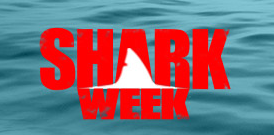- Share Shark Week: Fishing With the Best Curated Content on Facebook
- Share Shark Week: Fishing With the Best Curated Content on Twitter
- Share Shark Week: Fishing With the Best Curated Content on Linkedin
- Share Shark Week: Fishing With the Best Curated Content via email
I’m a self-proclaimed shark nerd. It’s true. We all have our little secrets, and I’m a big sucker for anything having to do with sharks. Hammerheads are my favorite. So as a shark nerd, I’m well aware of Shark Week on the Discovery Channel. Shark Week first aired in 1987, dedicated to creating awareness and respect for sharks. It is now the longest running event of its kind in the history of television.
Similar to having your content in the right place at the right time (like Oreo during the Superbowl), creating an integrated experience is a great way to keep an engaged audience. A combination of online, TV, and live-response social media curating allows a level of real-time, content-driven interaction with the potential to truly excite audiences.
Shark week has done something different for a TV program to engage its audience, using online, interactive content. They ask directly for viewers to tweet their responses to calls-to-action, with the chance for their tweet to show up on TV.
Each program has a specific hashtag creating a unique set of content for each show (in the above tweet it’s #Sharkzilla.) Content producers are curating real-time through the relevant responses, and picking the best tweets to showcase.
This is a unique approach to content curation from a medium that historically has low engagement in online spaces. Trends in recent years have shown that with the rise of laptops, tablets, and smartphones, buzz created online for TV can directly impact a show’s ratings. Shark Week has taken it to the next level, from live tweeting to live curating.
How can we take this a step further? It’s easy to overlook the importance of the content pyramid. Shark Week has a great opportunity to reach many more folks by taking the curated content they are generating through the pyramid. Why not take those tweeted suggestions and create a blog post, incorporating an additional call-to-action for more suggestions? Or your brand could take the curated tweets and create a coloring book online, allowing Twitter followers to generate their own creation, and provide an online vote with the winner receiving a prize. It’s all about generating more buzz, resulting in more content. And it all begins with a few curated tweets.
Now, you may be saying – what great creative ideas, but how does this affect our marketing and our curation efforts? Glad you asked! Again, I’ll reference the content pyramid. In a B2B environment, a popular strategy is to produce a webinar. The webinar, in a small way, relates to the TV experience from Shark Week. It’s a program you opt-in to engage with. You’re asking questions, and hopefully getting answers. Webinars allow attendees to ask direct questions. Why not curate those questions, and create a blog post answering the most popular ones? In addition, you could curate content from across to the web to support your answers, and create a follow-up newsletter to webinar attendees, referencing those answers along with curated content that supports your message.
Curation is not just a key marketing strategy to drive thought leadership and own industry conversations (similar to how Discovery owns Shark Week). It also allows companies to flesh out a more robust story they are trying to tell. Check out Curata’s Content Curation Look Book for case studies of real-world companies like Adobe and Intel who use curation successfully.




